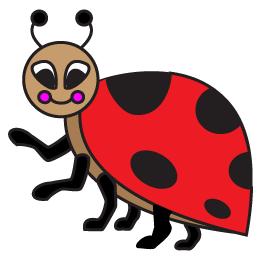

Click on my logo to go to my store!
 |
 Click on my logo to go to my store! |
|---|
| WEBBYWANDA.TV's LADYBUG SCIENCE FACTS |
|---|
 |
 |
 |
 |
 |
 |
 |
Lessons |
|---|
|
|
|---|
| Home | Blog | Videos | Characters | For Grown Ups | Voice Over Characters | Arts and Crafts | Educational | Webby Wanda's Shop |
|---|
PETS AND FARM ANIMALS FRUITS AND VEGETABLES HOLIDAYS |
|||||||
|
|
Thank you for visiting my Arts and Crafts web site!
I would be very grateful if you would please give the gift of creativity, and shop for your gifts at the stores on my site. |
|||||
FAST FACTS As ladybugs age, the color of their spots fades. A ladybug in flight beats its wings up to 85 times per second. There are about 5,000 different species of ladybugs in the world. These much loved pretty beetles are also known as lady beetles or ladybird beetles. They come in many different colors and patterns, but the most familiar in North America is the seven-spotted ladybug, with its shiny, red-and-black body. In many cultures around the world, ladybugs are considered good luck. Most people like them because they are pretty, graceful, and harmless to humans. But farmers love them because they eat aphids and other plant-eating pests. One ladybug can eat up to 5,000 insects in its lifetime! Most ladybugs have oval, dome-shaped bodies with six short legs. Depending on the species, they can have spots, stripes, or no markings at all. Seven-spotted ladybugs are red or orange with three spots on each side and one in the middle. They have a black head with white patches on either side. The brightly hued ladybugs are colorful for a reason. Their markings tell predators: "Eat something else! I taste terrible." When threatened, the bugs will secrete an oily, foul-tasting fluid from joints in their legs. They may also play dead. Birds are ladybugs' main predators, but they also fall victim to frogs, wasps, spiders, and dragonflies. Ladybugs lay their eggs in clusters or rows on the underside of a leaf, usually where aphids have gathered. Larvae, which vary in shape and color based on species, emerge in a few days. Seven-spotted ladybug larvae are long, black, and spiky-looking with orange or yellow spots. Larvae grow quickly and shed their skin several times. When they reach full size, they attach to a leaf by their tail, and a pupa is formed. Within a week or two, the pupa becomes an adult ladybug. Ladybugs are happy in many different habitats, including grasslands, forests, cities, suburbs, and along rivers. Seven-spotted ladybugs are native to Europe but were brought to North America in the mid-1900s to control aphid populations. Ladybugs are most active from spring until fall. When the weather turns cold, they look for a warm, secluded place to hibernate, such as in rotting logs, under rocks, or even inside houses. These hibernating colonies can contain thousands of ladybugs. The name "ladybug" was coined by European farmers who prayed to the Virgin Mary when pests began eating their crops. After ladybugs came and wiped out the invading insects, the farmers named them "beetle of Our Lady." This eventually was shortened to "lady beetle" and "ladybug."
|
HURRAH FOR LADYBUGS! Everyone loves the beautiful little red beetles that signal the start of warmer weather. Ladybugs are fierce predators, and some people raise them to help get rid of aphids. Be careful not to spray ladybugs with insecticide. LITTLE LUCKY CHARMS While many people are afraid of spiders and cockroaches, no one minds when a ladybug crawls up their finger. Lady bugs are considered lucky. Many people love to wear jewelry, with little charms of the ladybug. NATURES INSECTICIDE HOW DO LADYBUGS EAT BUGS? A ladybug lands on a rose or plant where hundreds of aphids suckle sap from the stem. A BABY LADYBUG The female finds a place where there is a lot of food nearby. She waits for warm weather and long days filled with sunlight. The female then lays her eggs on a leaf close to an aphid colony. Once the larvae begin to hatch, the ladybug flies away to find a suitable place to lay her next cluster of eggs. She will lay several clusters of eggs during the next month or two. Only moments after birth, the little ladybug larva begins to hunt. It feeds itself with aphids and grows quickly. After a few days, the larva is too big for its black skin, the larva sheds its outer skin, it splits and the larva crawls out and expands. The ladybug larva needs to eat and eat as it is still growing. One day its stops eating and sits still on a leaf. The larva sheds its skin to reveal the stiff, dry chrysalis, its protective covering, after ten days, the nymph begins to move , and the chrysalis tears away. A nymph is an insect that has not fully matured. A brand new ladybug escapes from its old skin. It is spotless and yellow. At first its elytra are soft, dull, and dimpled like the skin of an orange. The old, empty skin is left behind on the leaf. The ladybug opens its wings to dry them before starting its new life. The ladybug is orange when it emerges from its nymph stage, but it turns red a few hours later. The ladybug flexes its wings and is ready to fly into the world to find a new home. Just like the nursery rhyme. "Ladybug, ladybug, fly away home." Ladybugs breathe through openings on the sides of their bodies. In 1999, NASA sent ladybugs and aphids up in the space shuttle to test their movements in zero gravity. Though most ladybugs eat insects, a few species eat plants and are considered pests. There are more than 400 ladybug species in North America. A ladybug can retract its head into its body. The ladybug is the official insect of at least five U.S. states. "Face To Face with The Ladybug" Valerie Tracqui
|
||||||
 Panda Logo for webbywanda.com Tote Bag. by WebbyWanda BE KIND TO THE ENVIRONMENT Use a reusable tote bag! Thank You! COUPONS: http://www.zazzle.com/coupons |
|||||||
 Click here or on the Ladybug to go to webbywanda.tv's "How to draw a cartoon ladybug!" |
 Click here to learn how to draw a cartoon cricket with webbywanda.tv! |
|
|||||
| How to draw a cartoon ladybug with www.webbywanda.com, webbywanda.tv- All Copyrights Reserved 2012 ©, Ladybug Science Facts 2013 | |||||||
| Home | About Us | Contact Us | Videos | Affiliates | Advertise with us and Sponsors |
|---|
| Water Color with Wanda Copyright 2012 All Rights Reserved, ™ A production of Twin Dolphin Studios |
|---|
|
||